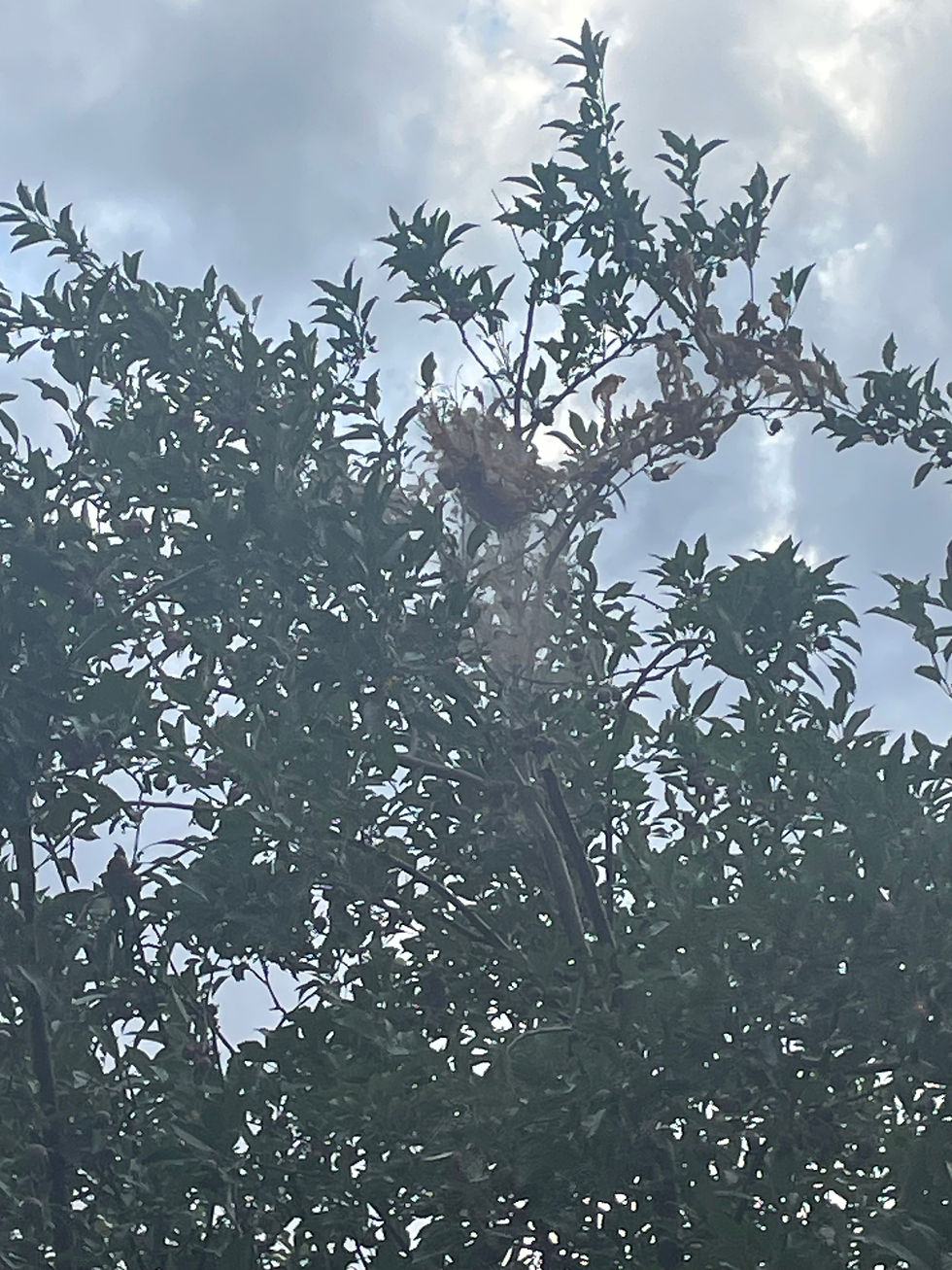Understanding Fall Webworms: Prevention and Treatment Strategies
- Kendra Morris

- Aug 13
- 4 min read
This is the time of year that I get customers bringing in photos or even branches of trees with webworms. Don't' panic! There are ways to prevent and treat them.
Fall webworms are a widespread pest that can cause serious damage to your trees and shrubs, especially in late summer and early fall. These caterpillars are infamous for their large silk webs that can consume entire branches, leading to unsightly damage and potential harm to your plants. Learning how to identify, prevent, and treat fall webworms is key to keeping your landscape healthy.
What Are Fall Webworms?
Fall webworms (Hyphantria cunea) are the larvae of a moth native to North America. They emerge in late summer, affecting a diverse range of trees, including fruit trees, ornamental trees, and shade trees. Typically, these caterpillars are green or yellow with black spots and can grow up to 1.5 inches long.
One of the most apparent signs of a fall webworm infestation is the silk webs they spin around branches and leaves. These webs act as protection for the caterpillars, making it hard for predators like birds or wasps to reach them. If you like to look at insects close up like me, it is really amazing how they spin this silky web that acts like a perfect protected house around the branch that they defoliate. A tree that is a common favorite for them is the Canada Red Chokecherry, I have seen several nests driving around town.
Identifying Fall Webworm Infestations
Recognizing the signs of a fall webworm infestation early can lead to timely removal. Here are clear indicators to watch for:
Webbing: The most visible sign is the presence of large webs on tree branches, which may contain numerous caterpillars.
Defoliation: When the caterpillars feast on the leaves, significant leaf loss can occur, weakening the tree and making it more prone to diseases.
Caterpillars: If you see green or yellow caterpillars with black spots, there’s a good chance fall webworms have invaded your garden.
By being vigilant for these signs, you can catch an infestation early and take action before extensive damage occurs.
Preventing Fall Webworms
Preventing fall webworms from taking root in your garden is the most effective way to mitigate these pests. Here are several actionable strategies:
1. Regular Monitoring
Inspect your trees and shrubs routinely for signs of webbing or caterpillars. Early detection could prevent a minor issue from becoming a full-blown infestation.
2. Pruning
If you see webs forming, prune the affected branches. Cutting away these branches can significantly reduce caterpillar populations and limit further damage. For example, a study found that homeowners who pruned heavily infested branches reduced the caterpillar population by up to 50%.
3. Encourage Natural Predators
Promote biodiversity in your garden to attract natural predators like birds and beneficial insects. Plant flowers that bloom at different times throughout the season to provide food sources for these helpful species.
4. Maintain Tree Health
Strong, healthy trees are less likely to suffer from pest infestations. Ensure your trees receive adequate water, nutrients, and sunlight. Providing balanced fertilizer can improve tree health and resistance, making them about 30% less susceptible to pests.
Treatment Options for Fall Webworms
If fall webworms have already taken over your trees, several treatment options can help. We carry several products that can be applied as a preventative or a treatment.
1. Manual Removal
For small infestations, manually removing webs and caterpillars can be effective. Wear gloves and use a stick to carefully pull down the webs and discard them, reducing the caterpillar population significantly.
2. Insecticidal Soap
Insecticidal soap is a safe and effective treatment for fall webworms. Spray infested areas according to the product instructions, making sure to cover all caterpillars. It can lead to a 70% reduction in caterpillar populations when applied correctly.
3. Bacillus thuringiensis (Bt)
Bacillus thuringiensis is a natural bacterium that specifically targets caterpillars without harming beneficial insects. Apply Bt to affected areas for substantial control when caterpillars are young, typically yielding a 90% effectiveness rate.
4. Chemical Insecticides
For severe infestations, chemical insecticides may be necessary. Choose a product specifically labeled for fall webworms and follow the instructions carefully. Use these only if other methods fail, as they can impact non-target species.
ALWAYS READ THE LABEL OF PRODUCTS BEFORE APPLICATION!
Timing Matters
Timing is crucial when dealing with fall webworms. The best time to treat an infestation is when the caterpillars are young and actively feeding, usually in late summer to early fall. By addressing the issue early, you can minimize damage and prevent caterpillars from maturing and spreading their webs further.
Protect Your Landscape
Fall webworms pose a significant threat to your trees and shrubs. However, by focusing on identification, prevention, and treatment, you can effectively manage these pests. Keep an eye on your plants, maintain their health, and use appropriate treatment options to ensure a thriving landscape.
Understanding the life cycle and behavior of fall webworms empowers you to take proactive measures to protect your plants. A healthy, well-cared-for garden can remain vibrant and resilient against these challenging pests for years to come.








Comments